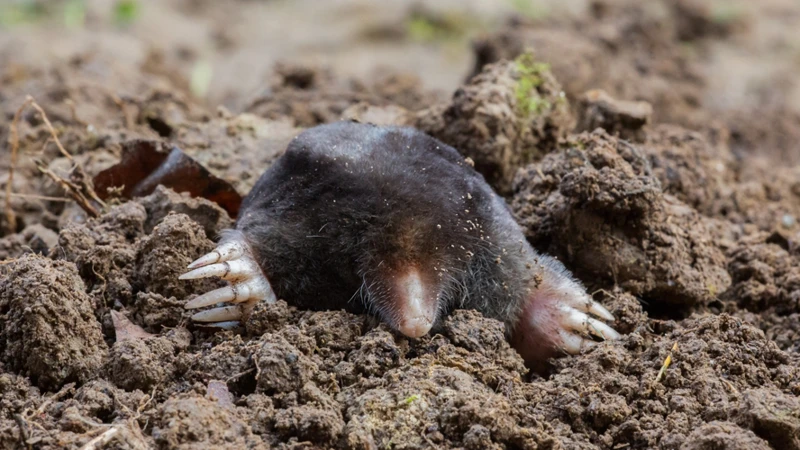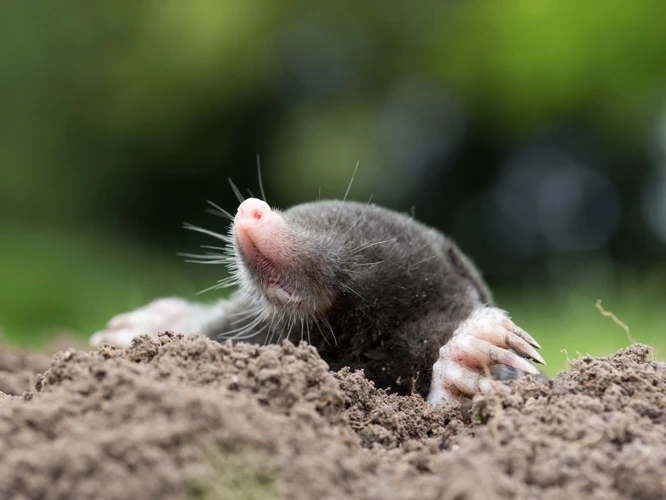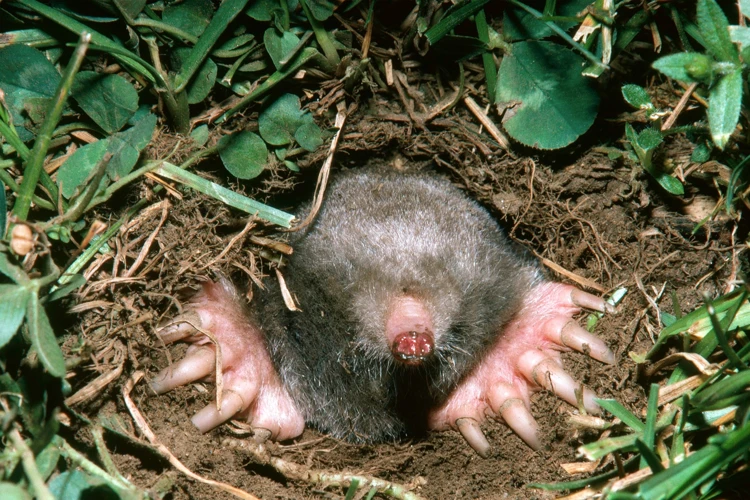The world of moles is a fascinating one, filled with complexities and nuances that are still not fully understood by scientists. These tiny creatures have the ability to navigate through their underground burrows with ease, even though their senses are not as acute as other animals. How do they do it? What methods do they use to communicate and navigate in their subterranean world? In this article, we will explore the behavior of moles, including their home range, territoriality, vision and hearing abilities, navigation methods, and communication tactics. Additionally, we will discuss humane ways to control moles and prevent them from causing damage to yards and gardens. Let’s delve into the mysterious world of moles and discover what makes them unique creatures.
The Mole’s Home Range and Territory

The subterranean lifestyle of moles has fascinated humans for centuries. One of the most interesting aspects of mole behavior is their home range and territory. These small mammals can inhabit a wide variety of environments, from forests to fields, and their territory can cover an area of up to several acres. In this section, we will explore the different factors that influence the size and layout of a mole’s home range, as well as their territorial behavior and aggression towards intruders. Understanding these behaviors can provide insight into better managing the presence of moles in your yard or garden. To learn more about mole behavior prevention, check out our article: Mole Behavior Prevention: How to Keep Your Yard Mole-Free.
Size and Layout of Home Range
Moles are solitary creatures that live in underground tunnels, which they create by digging. They spend most of their lives below ground and have a well-defined home range that they occupy. The size and layout of the home range can vary depending on various factors, such as the mole’s gender, age, food availability, and the type of soil they inhabit.
Typically, the size of a mole’s home range can range from 2,000 to 6,000 square meters, with some estimates suggesting that it could even reach up to 20,000 sq meters. This could mean that a single mole might occupy an area as big as a football field or more. While this seems like a large area, it is worth noting that moles spend most of their time below ground and are only occasionally seen above it.
The layout of the home range can vary depending on the mole’s requirements for food, water, shelter, and breeding. Moles prefer areas with moist and soft soils that facilitate digging and allow them to catch their prey. As a result, the home range may be limited to areas with suitable soil conditions. Moles are territorial and will defend their home range from other moles. They will mark their territory with urine and feces and may engage in aggressive behavior if another mole intrudes on their turf.
Understanding the size and layout of a mole’s home range is essential for managing mole populations. Moles are integral to the ecosystem and play a significant role in soil aeration and nutrient cycling. It is important to manage these creatures in a humane and effective way without causing undue harm. If you want to know more about moles’ roles in ecosystems or their digging behavior, you can check out our articles on moles in the ecosystem and moles’ digging behavior. Also, read about the mole’s diet and how it affects gardens. It is essential to consider the impact of weather changes on mole behavior and that they are, in fact, different from voles.
Territoriality and Aggression
Moles are known to be territorial animals, meaning they defend their home range against intruders. This is especially true when it comes to other moles of the same sex, as they are seen as direct competition for resources such as food and mates.
One way moles defend their territory is through aggression. This can include physical fights, which can leave wounds and scars, as well as territorial marking. Moles have scent glands on their body, which they use to mark their territory with a distinct odor.
However, it is important to note that aggression is not the only means of territorial defense. Moles may also use other methods such as intimidation displays to scare off potential intruders. These displays can include postures such as standing on hind legs and displaying their teeth.
Territoriality in moles serves an important purpose. By defending a specific home range, moles ensure they have access to enough food and resources to survive. It also reduces competition and prevents overpopulation. Despite their territorial nature, moles still have the ability to communicate and interact with other moles, as communication is important in mole society.
Mole Vision and Hearing

Despite spending most of their lives in complete darkness, moles are remarkable creatures with highly developed senses. They have evolved a unique set of adaptations that allow them to navigate and hunt in total darkness. In this section, we will explore the extraordinary visual and auditory abilities of these subterranean mammals. From the anatomy of their eyes and ears, to their limitations in perception, we will delve into the fascinating world of mole senses. So, let’s put on our moleskin spectacles and explore how moles see and hear in their underground world.
How Moles See and Hear
Moles have a unique sense of vision and hearing that allows them to navigate their underground environment. While their vision is limited, they rely heavily on their hearing to detect their prey and avoid predators. Here is a breakdown of how moles see and hear:
| Sense | Details |
|---|---|
| Vision | Moles have very poor eyesight due to the lack of light underground. Their eyes are very small and are covered in fur, making it difficult for them to see clearly. However, they are still able to detect light and dark, allowing them to distinguish between day and night. |
| Hearing | Moles have excellent hearing that allows them to detect the slightest vibrations in the soil. They have large eardrums that are able to pick up low-frequency sounds, such as those made by earthworms and insects, which are their primary food sources. |
Despite having limited vision, a mole’s keen sense of hearing helps them to locate their food and avoid danger in their underground environment.
Limitations of Mole Senses
Despite having highly evolved senses, moles also have their limitations — which can be a major hurdle in navigating their environment. Here are some of the key limitations of a mole’s senses:
- Visual Limitations: Although moles do have eyes, their vision is limited, and they cannot easily discern between different colors or shapes. This means that they may have trouble detecting obstacles in their path, which is not ideal for creatures that spend most of their lives underground.
- Hearing Limitations: Moles’ ears are small and not very sensitive. They can hear sounds, but not very well, especially at higher frequencies. Additionally, sounds travel poorly through soil, which makes it a less useful sense for navigating underground.
- Olfactory Limitations: While moles have a highly developed sense of smell, it is not always a reliable method for detecting predators or finding food. The environment underground can be highly saturated with smells, which makes discriminating between different odors difficult.
- Tactile Limitations: Moles rely heavily on their sense of touch to navigate their environment. However, this sense is not infallible, as they need to come into contact with an object in order to sense it. The soil can mask some tactile information and even disarm the mole’s senses.
These limitations make it all the more impressive that moles are so successful at living underground! However, it also highlights the importance of understanding mole behavior and using humane methods to control them if they become a nuisance.
Mole Navigation Methods

As subterranean creatures, moles face the challenge of navigating through a complex system of tunnels and burrows to reach their desired destination. Yet, these small mammals have developed a unique set of navigation methods that allow them to move effortlessly through their environment. In this section, we will explore the fascinating ways in which moles navigate their underground world, including their use of magnetoreception, sense of smell and touch, and other sensory adaptations that help them find their way.
Magnetoreception
When it comes to navigating their environment, moles have a secret weapon that sets them apart from other mammals. This weapon is a unique ability called magnetoreception. Magnetoreception is a sense that allows moles to perceive the Earth’s magnetic field and use it as a sort of compass to orient themselves.
How does magnetoreception work?
Moles have tiny crystals of magnetite in their noses that are sensitive to the Earth’s magnetic field. These crystals, known as magnetosomes, are connected to nerve cells in the mole’s upper nasal cavity. When the crystals move in response to changes in the magnetic field, they create an electric current that triggers signals in the nerve cells.
What is the purpose of magnetoreception?
Magnetoreception allows moles to navigate their complex underground tunnels and locate food sources. Moles use their sense of direction to keep track of where they are in relation to their home range and to avoid crossing into other moles’ territories.
How precise is magnetoreception?
While magnetoreception is incredibly useful for moles, it is not foolproof. The Earth’s magnetic field can fluctuate due to factors like solar activity, which can throw the mole’s compass off. Additionally, magnetoreception is not as precise as other forms of navigation, like vision or scent. However, when combined with other senses, magnetoreception allows moles to have a multi-faceted approach to navigating their environment.
Do all moles have magnetoreception?
Not all species of moles have the same level of magnetoreception. Some species, like the European mole, have a highly developed sense of magnetoreception, while others, like the Townsend’s mole, have much less developed abilities. The level of magnetoreception is believed to be related to the mole’s habitat and lifestyle. Moles that live in more complex environments, like European moles, are believed to rely more heavily on their sense of magnetoreception.
Sense of Smell and Touch
Moles have a highly developed sense of smell and touch which allows them to navigate their environment and locate prey. Their snouts are covered in sensory hairs called Eimer’s organs, which are sensitive to scent particles in the air. These organs contain nerve endings that send signals to the mole’s brain when they come into contact with certain odor molecules.
In addition to their sense of smell, moles also rely heavily on their sense of touch. Their front paws are equipped with long, sharp claws that allow them to dig through soil and detect the location of prey. These claws also have sensory receptors that allow moles to feel vibrations and changes in the environment.
Moles have a specialized adaptation called the “star nose,” which is a ring of protruding flesh around their snout that is covered in tiny sensory tentacles. These tentacles contain touch receptors that allow moles to feel their way through tunnels and detect changes in the environment.
In combination, the mole’s sense of smell and touch allows them to navigate underground and locate prey without relying on their limited vision. They can follow scent trails left by other moles or prey, detect changes in the soil texture or moisture levels, and locate the presence of nearby predators.
Table:
| Sense | Description | Function |
|---|---|---|
| Smell | Eimer’s organs | Sensitive to scent particles in the air |
| Touch | Sharp claws and sensory receptors | Allows moles to feel vibrations and changes in the environment, detect changes in soil texture or moisture levels |
| Special adaptation | “Star nose” with sensory tentacles | Allows moles to feel their way through tunnels and detect changes in the environment |
Mole Communication

Moles are solitary animals that spend a significant amount of time underground, but that doesn’t mean they don’t communicate with each other. In fact, communication is an integral part of mole society, with various forms of communication employed to establish territories, find mates, and warn each other of dangers. Let’s delve into the fascinating world of mole communication and discover how these underground animals stay connected.
Signs of Mole Communication
Moles are known to be solitary animals, but they do communicate with one another through various means. Some signs of mole communication include:
- Mounds and tunnels: Moles can communicate with each other by leaving scent markers such as urine and feces in their tunnels and mounds. They use their sense of smell to detect these markers and can determine the identity and social status of other moles in the area.
- Surface runways: Moles can also leave above-ground trails or runways that serve as communication pathways, allowing them to navigate their environment and locate other moles in the area. They leave visual markers along these pathways, such as small piles of soil, to indicate their presence.
- Aggression: Male moles may also display aggressive behaviors, such as fighting and chasing, in order to establish dominance over a territory or to compete for a mate. This aggressive behavior can serve as a form of communication, providing information about social status and potential threats to other moles in the area.
These signs of mole communication can give us insight into the complex social behaviors of these animals, despite their solitary lifestyles.
Types of Mole Vocalizations
One way that moles communicate with each other is through vocalizations. While it might be hard for humans to recognize and interpret these sounds, moles use them to convey important messages to their fellow animals. Here are some examples of the different types of mole vocalizations:
- Grunting: Moles produce a deep, low-pitched grunt to indicate alarm or danger. This serves as a warning to other moles in the vicinity that they should be on alert.
- Chattering: This vocalization is characterized by fast, rapid-fire sounds that resemble the chattering of teeth. Moles use chattering to signal aggression, especially during territorial disputes.
- Clicking: Moles produce a clicking sound by snapping their jaws together. This is typically used as a submissive signal during encounters with dominant moles or to communicate playfulness with other moles.
- Squeaking: Moles occasionally make a high-pitched squeaking sound, which is thought to be a form of distress call. This sound is produced when a mole feels threatened or is in pain.
- Humming: Moles sometimes hum, producing a low-pitched, musical sound. While the purpose of humming is not entirely clear, researchers believe it may be used to indicate contentment or relaxation.
Understanding these vocalizations can provide insights into mole behavior and social dynamics. By paying attention to the different sounds moles make, researchers can learn more about how these animals communicate with each other in their subterranean world.
Role of Communication in Mole Society
Moles are solitary creatures that prefer to live alone in their home range. However, despite their solitary lifestyle, communication is still an important aspect of mole society.
Role of Communication in Mole Society
| Communication | Purpose |
| — | — |
| Visual | Used in courtship and territorial disputes |
| Tactile | Used in mating and social grooming |
| Vocalizations | Used for communication with other moles |
Moles use a combination of visual, tactile and vocal communication to convey important information to other moles in their territory. In courtship, visual communication is used to signal intentions through body posture and movements. Additionally, moles will also use visual signals to assert their dominance over one another during territorial disputes.
Tactile communication in moles is important for mating and social grooming. During mating, the male will search for the female by following her scent trail. Once found, tactile communication is used to reinforce their bond and stimulate mating behaviors. Social grooming, on the other hand, is used to establish social bonds and cooperative behaviors.
Vocalizations in moles are also an important aspect of their communication. Moles have a range of vocalizations that include grunts, squeaks, and trills. These vocalizations can be used to express a range of emotions, from aggression to fear. Additionally, moles will also use vocalizations to communicate with other moles, especially during mating and territorial disputes.
Even though moles are solitary creatures, communication is still an essential part of their lifestyle. Through a combination of visual, tactile, and vocal communication, moles are able to establish social bonds, assert dominance and navigate their environment.
How to Control Moles Humanely
When moles invade our gardens and lawns, they can quickly become a nuisance. While they may be fascinating creatures, their burrowing and tunneling can cause damage to plants and ruin the aesthetics of a well-manicured lawn. However, it is important to remember the value moles bring to the ecosystem as they play a crucial role in soil aeration and pest control. As such, it is crucial to control moles humanely. In this section, we will explore the different methods for controlling moles without harming them. From preventative measures to live trapping and relocation, we will delve into the most effective and humane ways to deal with mole infestations.
Preventative Measures
One effective way to control moles is through preventative measures. By making the environment less conducive to mole habitation, homeowners can avoid the costly and cumbersome process of trapping and relocation. The following preventative measures can limit the allure of your yard to these underground pests:
- Reduce Watering: Moles prefer moist soil, so reducing your lawn watering can decrease mole activity.
- Eliminate Grub Worms: Grubs are one of moles’ favorite foods, so using a grub control treatment can help reduce the number of moles attracted to your lawn.
- Landscape Strategically: Moles are drawn to yards with thick vegetation, like gardens and flower beds. Keep these areas away from your lawn to limit mole activity.
- Install Barriers: Consider installing barriers around your yard, such as underground fencing or mesh netting, to prevent moles from entering.
- Reduce Residual Food: Leaving pet food or birdseed on the ground can attract small insects, which in turn attract moles. Make sure to clean up residual food regularly.
- Monitor Lawn Damage: Regularly monitor your lawn for new mole activity. By catching the issue early, homeowners can take preventative measures to avoid more significant damage.
By implementing these measures, homeowners can reduce the likelihood of attracting moles to their yards.
Live Trapping and Relocation
Live Trapping and Relocation: One of the more humane methods of controlling moles is to live trap and relocate them. Live trapping involves setting traps that capture the mole unharmed, allowing it to be relocated to a new area where it will not cause damage.
There are several types of live traps available on the market, each designed for specific needs and preferences. Here are some of the most commonly used live traps for moles:
| Trap Type | Description | Advantages | Disadvantages |
|---|---|---|---|
| Cage Traps | These traps are designed to capture the mole unharmed and keep it contained until it can be released in a new location. | Effective in capturing moles without harming them. Reusable and easy to set up. | Can be expensive. Requires frequent monitoring to ensure that the captured mole is released in a new, suitable location. |
| Pitfall Traps | These traps are essentially holes dug into the ground with a bucket or container placed inside. The mole falls into the container and can be easily removed and relocated. | Easy to set up and low cost. Effective in capturing moles. | Can be dangerous for other animals or pets if left unattended. Requires constant monitoring to ensure that new moles are captured. |
| Bottle Traps | These traps are designed to capture the mole when it enters the trap to retrieve food. The mole will fall into a container or bottle and can be easily removed and relocated. | Relatively inexpensive and easy to set up. Effective in capturing moles. | Requires frequent monitoring to ensure that the captured mole is released in a new, suitable location. May not be effective in some situations. |
Live trapping and relocation is a humane method of controlling moles but it does require significant effort and resources. Before using this method, it is important to check with local wildlife authorities to ensure that it is legal in your area. Additionally, it is important to release the mole in a new location that is suitable for its survival, so it does not cause harm to a new ecosystem.
Repellents and Exclusion
Repellents and Exclusion
Another humane way of controlling moles is by using repellents and exclusion methods. These methods are designed to keep moles away from certain areas without harming them.
One of the most effective repellents is castor oil. Castor oil can be mixed with dish soap and water, then sprayed onto the ground. This creates an unpleasant smell and taste for the moles, causing them to leave the area. Other natural repellents include garlic, cayenne pepper, and coffee grounds.
Another way to exclude moles from certain areas is by installing physical barriers such as mesh or fencing. These barriers should be buried at least a foot below ground to prevent the moles from digging under them. However, this method can be costly and time-consuming.
Ultrasonic repellents are another popular option. These devices emit high-pitched sounds that are undetectable to humans but annoying to moles. They can be placed around the perimeter of the lawn or garden to keep moles away. However, it should be noted that the effectiveness of these devices is debatable.
For those who prefer commercial solutions, there are several mole repellent products available on the market. These products contain natural ingredients such as peppermint oil or sound vibrations to deter moles.
Before choosing a repellent or exclusion method, it is important to identify the extent of the mole problem and the location of their tunnels. This will help determine the most effective solution.
|Method |Description|
|——-|———–|
|Castor oil |Mixed with dish soap and water, sprayed onto ground to create unpleasant smell and taste|
|Mesh or fencing |Physical barriers buried at least a foot below ground to prevent moles from digging under|
|Ultrasonic repellents |Devices that emit high-pitched sounds undetectable by humans but annoying to moles|
|Mole repellent products |Commercial products containing natural ingredients or sound vibrations to deter moles|
Conclusion
In conclusion, moles are fascinating creatures that have developed unique ways of navigating their environment. Despite their small size, they have a complex system of establishing and defending territories, using their senses of touch, smell, and magnetoreception to navigate underground.
While moles are generally solitary creatures, they do communicate with each other through a series of vocalizations and physical signs. Their communication system allows them to establish social hierarchies and defend their territories from intruders.
Unfortunately, moles can also cause damage to lawns and gardens, leading many homeowners to seek ways to control them. While live trapping and relocation is considered the most humane method, preventative measures and the use of repellents and exclusion methods can also be effective.
Overall, the more we understand about moles and their behavior, the better equipped we are to coexist with them in a mutually beneficial way. By respecting their unique needs and finding ways to peacefully coexist, we can appreciate the important role moles play in the ecosystem.
Frequently Asked Questions
What is the home range of a mole?
A mole’s home range can be anywhere from 1/4 to 2 acres in size.
How does a mole defend its territory?
Moles are territorial and will defend their territory aggressively against other moles.
Can moles see and hear?
Moles have very limited vision and hearing, but rely on their other senses to navigate their environment.
How do moles navigate?
Moles navigate using a combination of magnetoreception, sense of smell, and touch.
Do moles communicate with each other?
Yes, moles communicate with each other through a variety of vocalizations and signs.
How do you humanely control moles?
There are several humane methods to control moles, including preventative measures, live trapping and relocation, and repellents and exclusion.
What are some preventative measures for mole control?
Preventative measures include reducing soil moisture and using physical barriers to prevent moles from digging in unwanted areas.
Is live trapping and relocation a humane method of mole control?
Yes, live trapping and relocation is a humane method of mole control as long as the mole is released in a suitable habitat.
What are some natural repellents for moles?
Natural repellents include plantings such as daffodils, alliums, and fritillaries, as well as castor oil and garlic sprays.
Why is it important to control moles?
Moles can cause damage to lawns, gardens, and agricultural crops, as well as create tripping hazards in fields and pastures.







